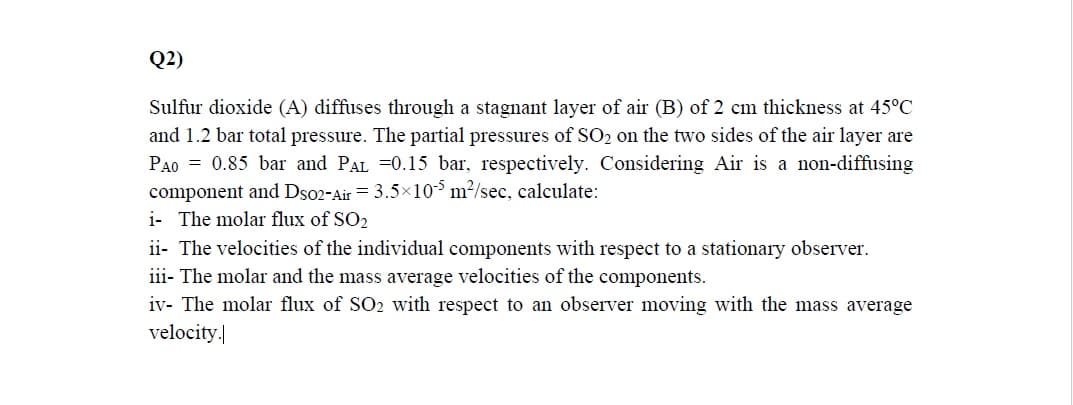Q2) Sulfur dioxide (A) diffuses through a stagnant layer of air (B) of 2 cm thickness at 45°C and 1.2 bar total pressure. The partial pressures of SO2 on the two sides of the air layer are = 0.85 bar and PAL =0.15 bar, respectively. Considering Air is a non-diffusing component and Dso2-Air = 3.5×10-$ m²/sec, calculate: i- The molar flux of SO2 PAO ii- The velocities of the individual components with respect to a stationary observer. iii- The molar and the mass average velocities of the components. iv- The molar flux of SO2 with respect to an observer moving with the mass average velocity.
Q2) Sulfur dioxide (A) diffuses through a stagnant layer of air (B) of 2 cm thickness at 45°C and 1.2 bar total pressure. The partial pressures of SO2 on the two sides of the air layer are = 0.85 bar and PAL =0.15 bar, respectively. Considering Air is a non-diffusing component and Dso2-Air = 3.5×10-$ m²/sec, calculate: i- The molar flux of SO2 PAO ii- The velocities of the individual components with respect to a stationary observer. iii- The molar and the mass average velocities of the components. iv- The molar flux of SO2 with respect to an observer moving with the mass average velocity.
Chemistry
10th Edition
ISBN:9781305957404
Author:Steven S. Zumdahl, Susan A. Zumdahl, Donald J. DeCoste
Publisher:Steven S. Zumdahl, Susan A. Zumdahl, Donald J. DeCoste
Chapter1: Chemical Foundations
Section: Chapter Questions
Problem 1RQ: Define and explain the differences between the following terms. a. law and theory b. theory and...
Related questions
Question
Sulfur dioxide (A) diffuses through a stagnant layer of air (B) of 2 cm thickness at 45oC and 1.2 bar total pressure. The partial pressures of SO2 on the two sides of the air layer are PA0 = 0.85 bar and PAL =0.15 bar, respectively. Considering Air is a non-diffusing component and DSO2-Air = 3.5×10-5 m2/sec, calculate:
1) The molar flux of SO2 with respect to an observer moving with the mass average velocity.

Transcribed Image Text:Q2)
Sulfur dioxide (A) diffuses through a stagnant layer of air (B) of 2 cm thickness at 45°C
and 1.2 bar total pressure. The partial pressures of SO2 on the two sides of the air layer are
PAO = 0.85 bar and PAL =0.15 bar, respectively. Considering Air is a non-diffusing
component and Dso2-Air = 3.5×10$ m²/sec, calculate:
i- The molar flux of SO2
ii- The velocities of the individual components with respect to a stationary observer.
iii- The molar and the mass average velocities of the components.
iv- The molar flux of SO2 with respect to an observer moving with the mass average
velocity.
Expert Solution
This question has been solved!
Explore an expertly crafted, step-by-step solution for a thorough understanding of key concepts.
Step by step
Solved in 2 steps with 1 images

Knowledge Booster
Learn more about
Need a deep-dive on the concept behind this application? Look no further. Learn more about this topic, chemistry and related others by exploring similar questions and additional content below.Recommended textbooks for you

Chemistry
Chemistry
ISBN:
9781305957404
Author:
Steven S. Zumdahl, Susan A. Zumdahl, Donald J. DeCoste
Publisher:
Cengage Learning

Chemistry
Chemistry
ISBN:
9781259911156
Author:
Raymond Chang Dr., Jason Overby Professor
Publisher:
McGraw-Hill Education

Principles of Instrumental Analysis
Chemistry
ISBN:
9781305577213
Author:
Douglas A. Skoog, F. James Holler, Stanley R. Crouch
Publisher:
Cengage Learning

Chemistry
Chemistry
ISBN:
9781305957404
Author:
Steven S. Zumdahl, Susan A. Zumdahl, Donald J. DeCoste
Publisher:
Cengage Learning

Chemistry
Chemistry
ISBN:
9781259911156
Author:
Raymond Chang Dr., Jason Overby Professor
Publisher:
McGraw-Hill Education

Principles of Instrumental Analysis
Chemistry
ISBN:
9781305577213
Author:
Douglas A. Skoog, F. James Holler, Stanley R. Crouch
Publisher:
Cengage Learning

Organic Chemistry
Chemistry
ISBN:
9780078021558
Author:
Janice Gorzynski Smith Dr.
Publisher:
McGraw-Hill Education

Chemistry: Principles and Reactions
Chemistry
ISBN:
9781305079373
Author:
William L. Masterton, Cecile N. Hurley
Publisher:
Cengage Learning

Elementary Principles of Chemical Processes, Bind…
Chemistry
ISBN:
9781118431221
Author:
Richard M. Felder, Ronald W. Rousseau, Lisa G. Bullard
Publisher:
WILEY